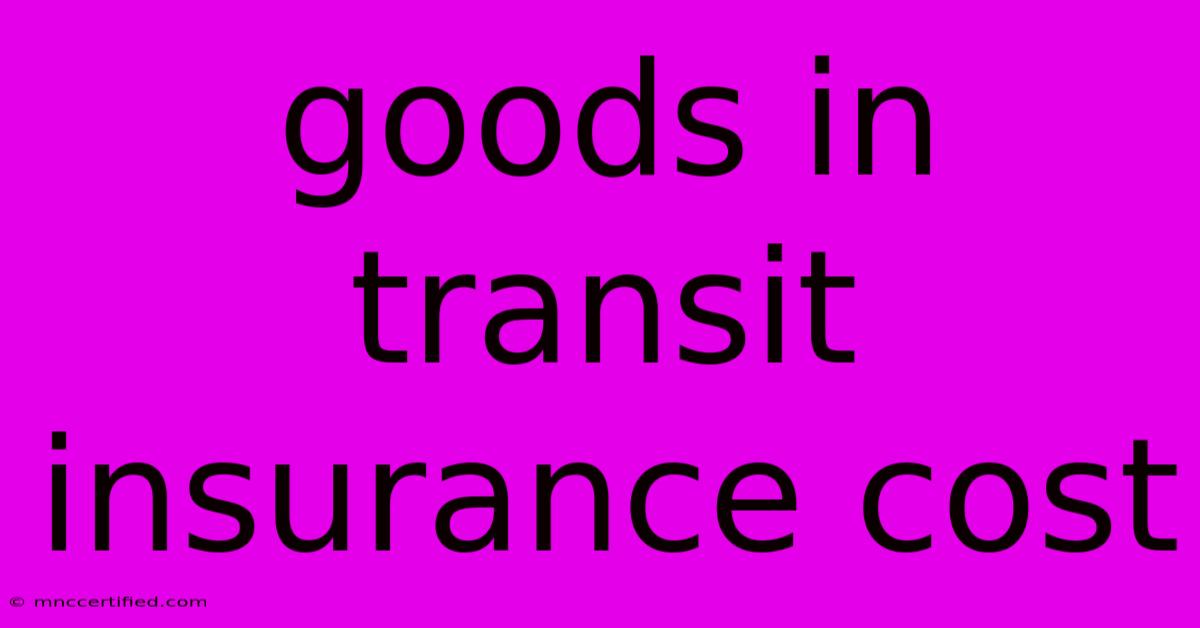Goods In Transit Insurance Cost

Table of Contents
Goods in Transit Insurance Cost: A Comprehensive Guide
Shipping goods across borders or even domestically involves inherent risks. Accidents, theft, and damage can lead to significant financial losses. This is where goods in transit insurance (also known as cargo insurance) steps in, offering crucial protection for your shipments. But how much does this vital coverage cost? This comprehensive guide will break down the factors influencing the cost of goods in transit insurance and help you understand what to expect.
What Factors Determine Goods in Transit Insurance Cost?
Several key factors interact to determine the premium you'll pay for goods in transit insurance. Understanding these allows you to make informed decisions and potentially negotiate better rates.
1. Value of Goods: This is the most significant factor. The higher the declared value of your shipment, the higher your insurance premium will be. This is because the insurer's potential payout increases with the value of the goods. Accurate valuation is crucial – under-declaring can invalidate your claim, while over-declaring unnecessarily inflates your costs.
2. Type of Goods: Different goods carry different risk profiles. Fragile items, high-value electronics, or perishable goods are inherently riskier to transport and will command higher premiums than less susceptible goods. The insurer will assess the inherent risk associated with the specific nature of your cargo.
3. Mode of Transport: The chosen mode of transportation (road, sea, air, rail) significantly impacts insurance costs. Air freight, for example, is generally more expensive to insure than sea freight, due to the higher speed and potentially more volatile conditions. The associated risks differ substantially between modes, influencing premium calculations.
4. Destination and Origin: The routes involved in your shipment impact insurance costs. Regions known for higher crime rates or unstable political situations will typically result in higher premiums due to increased risk of theft, damage, or loss. Consider the journey's inherent risks.
5. Coverage Type: Insurance policies offer various coverage levels. Basic coverage might only protect against specific perils (e.g., fire or theft), while comprehensive coverage offers broader protection against a wider range of risks, including accidental damage and even delays. Higher coverage naturally translates to higher premiums.
6. Inherent Vice: This refers to damage or loss caused by the nature of the goods themselves. For example, perishable goods decaying during transit due to their own nature might not be fully covered. Policies often have exclusions for inherent vice, which can influence the overall cost and what risks are covered.
7. Insurer and Policy Terms: Different insurers have different pricing structures and policy terms. Some may offer more competitive rates than others, based on their risk assessment models and market strategies. Comparing quotes from multiple insurers is highly recommended. Read the policy details carefully before committing.
How to Reduce Goods in Transit Insurance Costs
While you can't entirely eliminate the cost, you can implement strategies to reduce it:
- Improve Packaging: Secure and robust packaging minimizes the risk of damage during transit, potentially leading to lower premiums. Investment in high-quality packaging is a cost-effective preventative measure.
- Choose Reliable Carriers: Opting for reputable and experienced carriers with a strong safety record can reduce the likelihood of incidents, influencing the insurer's risk assessment and premiums.
- Negotiate with Insurers: Don't hesitate to negotiate with insurers, especially if you have a strong shipping history with few claims. Volume discounts may also be available for regular shippers.
- Consider Self-Insurance (for larger businesses): Large companies with consistent shipping volumes might consider self-insurance options, but this requires careful financial planning and risk assessment.
Conclusion: Balancing Cost and Coverage
Goods in transit insurance is an essential investment for businesses of all sizes. While the cost can vary considerably based on several factors, understanding these factors allows you to make informed decisions about your coverage needs and potentially reduce your premiums without sacrificing adequate protection for your valuable shipments. Remember to always compare quotes, read policy terms carefully, and prioritize choosing the level of coverage that best suits your specific needs and risk profile. Don't compromise on security; find the right balance between cost-effectiveness and comprehensive protection for your goods in transit.

Thank you for visiting our website wich cover about Goods In Transit Insurance Cost. We hope the information provided has been useful to you. Feel free to contact us if you have any questions or need further assistance. See you next time and dont miss to bookmark.
Featured Posts
-
Matchday Menu Seedorfs Ucl First Appearance
Nov 26, 2024
-
Is Avastin Covered By Insurance
Nov 26, 2024
-
Celtics Refining Late Game Execution
Nov 26, 2024
-
Db Cooper Parachute Found Mc Coy Case Reignited
Nov 26, 2024
-
City Of Dallas Dental Insurance
Nov 26, 2024